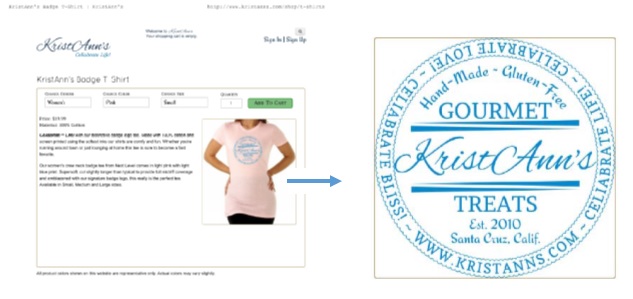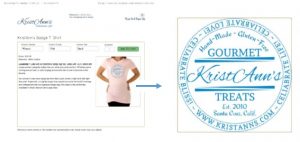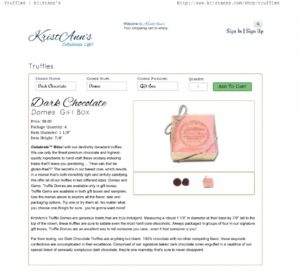TTAB Reverses Examiner’s Refusal, Finding That Unorthodox Proof of Commercial Use Was Valid

When a trademark applicant seeks to submit a statement of use to the USPTO, it must provide a specimen that shows the mark being ‘used in commerce’. This specimen must be a substantially exact representation of the mark as used on or in connection with the goods and/or services. In In Re Kristin A. Harris, the Trademark Trial and Appeal Board reversed a Trademark Examining Attorney’s finding that the specimens Applicant provided were not sufficient to satisfy the use-in-commerce requirement. In re Kristin A. Harris, Proc. No. 77807042 (T.T.A.B. Jan. 23, 2015).
The Applicant, Kristin Harris, sought to register CELIABRATE in four classes, for goods and services including gift bags, shirts, baked goods, and a website promoting medical information about Celiac’s disease. She based her application on an intent-to-use basis and later submitted a statement of use showing the mark in use on her goods and services for sale on her website. In addition to her original specimens, she submitted supplemental specimens in response to the Office Action showing how the mark was used on, or before, the statement of use date.
(Applicant’s specimen is the first image on the left. The second image is the logo blown up.)
Applicant also used the mark below the KRISTANN’s mark and in the products’ descriptions. (Highlighting added by blog author.)
The Examiner argued that the CELIABRATE mark was being used a composite mark because CELIABRATE was not separable from the phrases “CELIABRATE LOVE!” “CELIABRATE LIFE” & “CELIABRATE BLISS” in the Applicant’s specimens. Therefore, the specimens did not show that the mark CELIABRATE was in use in commerce as a unitary mark.
The TTAB disagreed and held that the CELIABRATE mark functioned as a unitary mark and that the specimens were sufficient to show use in commerce. It started off by stating that Applicant “may seek to register any portion of a composite mark if that portion presents a separate and distinct commercial impression which indicates the source of [A]pplicant’s goods or services.” It then analyzed the specimens and held that, while the CELIABRATE portion of the mark is used next to words like LOVE, LIFE & BLISS in the same size and style, the “this does not end the inquiry as to the commercial impression” of the mark.
The Board found that the one shared element of the logo used on all of the goods is the word CELIABRATE, which is a coined, fanciful word. Applicant used the CELIABRATE mark in conjunction with “CELIABRATE LIFE!” “CELIABRATE LOVE!” “CELIABRATE BLISS!” “CELIABRATE™ INSPIRATION” and “CELIABRATE EVERYTHING.” Therefore, the Board held, “because it is used often and consistently, in various ways, …CELIABRATE will be perceived as a source identifier.” If the Applicant had used the mark consistently with one word, the Board stated that it would less likely to form a distinct commercial impression on consumers. The TTAB found, however, that the use of the coined term CELIABRATE with multiple non-fanciful words caused the mark to form its own distinct commercial impression. In addition, the Board held that the use of TM after CELIABRATE™ INSPIRATION in the description of the goods reinforced their findings.
This was, as the TTAB stated, a close case and the Applicant narrowly won based by the fact that CELIABRATE is a fanciful word and that the Applicant used the mark next to many different non-fanciful words, like LOVE & LIFE. As a best practice, when an applicant applies for a unitary mark, it should use the mark by itself or should, in some way, attempt to present the mark in a way that is distinct from the words and images it is used in conjunction with. Otherwise, an examiner may find that the mark is not being used in commerce. There appeared to be other possible deficiencies in the Applicant’s mark not addressed by the TTAB, such as whether the mark’s use on t-shirts was an ornamental use but the examiner could still bring this ground as a separate refusal when the mark is remanded to the examiner for further consideration.
THREE TAKEAWAYS
ONE. The USPTO will register an element of a composite mark if that element has its own unique commercial impression.
TWO. Additional specimens can be submitted to show use in commerce ONLY if those specimens reflect the goods and/or services on or before the Applicant signed its statement of use.
THREE. While this case is likely an exception that proves the rule, applicant’s should always make sure that the mark they apply for is used in a way that creates a clear commercial impression from its surroundings.
Do you need assistance with a trademark matter?
Contact an Attorney Today

